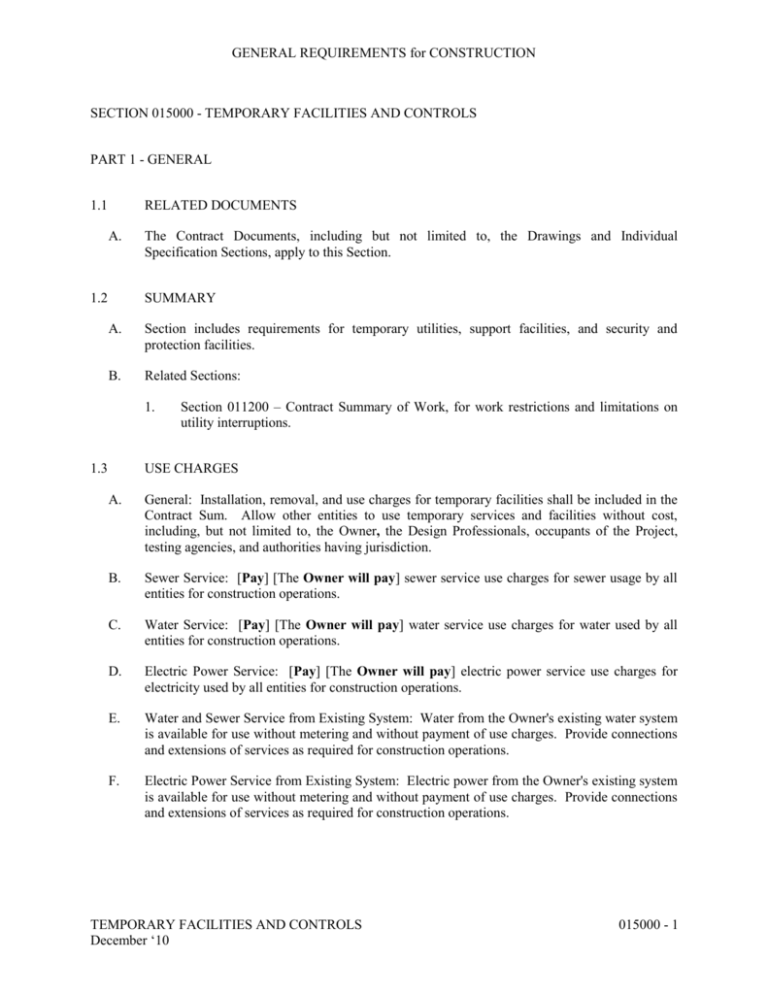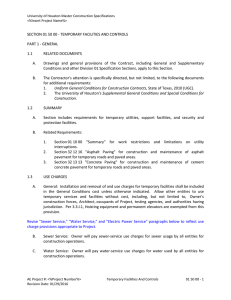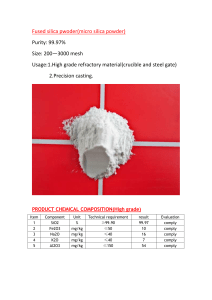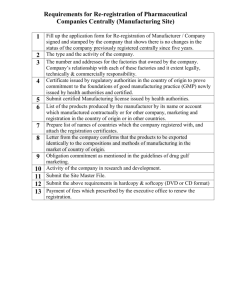k - Section 015000 - Temporary Facilities and Controls
advertisement

GENERAL REQUIREMENTS for CONSTRUCTION SECTION 015000 - TEMPORARY FACILITIES AND CONTROLS PART 1 - GENERAL 1.1 RELATED DOCUMENTS A. 1.2 The Contract Documents, including but not limited to, the Drawings and Individual Specification Sections, apply to this Section. SUMMARY A. Section includes requirements for temporary utilities, support facilities, and security and protection facilities. B. Related Sections: 1. 1.3 Section 011200 – Contract Summary of Work, for work restrictions and limitations on utility interruptions. USE CHARGES A. General: Installation, removal, and use charges for temporary facilities shall be included in the Contract Sum. Allow other entities to use temporary services and facilities without cost, including, but not limited to, the Owner, the Design Professionals, occupants of the Project, testing agencies, and authorities having jurisdiction. B. Sewer Service: [Pay] [The Owner will pay] sewer service use charges for sewer usage by all entities for construction operations. C. Water Service: [Pay] [The Owner will pay] water service use charges for water used by all entities for construction operations. D. Electric Power Service: [Pay] [The Owner will pay] electric power service use charges for electricity used by all entities for construction operations. E. Water and Sewer Service from Existing System: Water from the Owner's existing water system is available for use without metering and without payment of use charges. Provide connections and extensions of services as required for construction operations. F. Electric Power Service from Existing System: Electric power from the Owner's existing system is available for use without metering and without payment of use charges. Provide connections and extensions of services as required for construction operations. TEMPORARY FACILITIES AND CONTROLS December ‘10 015000 - 1 GENERAL REQUIREMENTS for CONSTRUCTION 1.4 INFORMATIONAL SUBMITTALS A. Site Plan: Show temporary facilities, utility hookups, staging areas, and parking areas for construction personnel. B. Erosion and Sedimentation Control Plan: Show compliance with requirements of New York State Department of Environmental Conservation Stormwater General Permit or authorities having jurisdiction, whichever is more stringent. C. Moisture-Protection Plan: Describe procedures and controls for protecting materials and construction from water absorption and damage; including delivery, handling, and storage provisions for materials subject to water absorption or water damage, discarding water-damaged materials, protocols for mitigating water intrusion into completed Work, and replacing water damaged Work. 1. D. Dust-Control and HVAC-Control Plan: Submit coordination drawing and narrative that indicates the dust-control and HVAC-control measures proposed for use, proposed locations, and proposed time frame for their operation. Identify further options if proposed measures are later determined to be inadequate. Include the following: 1. 2. 3. 4. 5. 1.5 Indicate sequencing of work that requires water, such as sprayed fire-resistive materials, plastering, and terrazzo grinding, and describe plans for dealing with water from these operations. Show procedures for verifying that wet construction has dried sufficiently to permit installation of finish materials. Locations of dust-control partitions at each phase of the work. HVAC system isolation schematic drawing. Location of proposed air filtration system discharge. Other dust-control measures. Waste management plan. QUALITY ASSURANCE A. Electric Service: Comply with NECA, NEMA, and UL standards and regulations and requirements of authority having jurisdiction for temporary electric service. Install service to comply with NFPA 70. B. Tests and Inspections: Arrange for authorities having jurisdiction to test and inspect each temporary utility before use. Obtain required certifications and permits. C. Accessible Temporary Egress: Comply with applicable provisions in ADA-ABA Accessibility Guidelines and ANSI A117.1. 1.6 PROJECT CONDITIONS A. Temporary Use of Permanent Facilities: Engage installer of each permanent service to assume responsibility for operation, maintenance, and protection of each permanent service during its use as a construction facility before the Owner's acceptance, regardless of previously assigned responsibilities. TEMPORARY FACILITIES AND CONTROLS December ‘10 015000 - 2 GENERAL REQUIREMENTS for CONSTRUCTION PART 2 - PRODUCTS 2.1 MATERIALS A. Chain-Link Fencing: Minimum 0.148-inch thick, galvanized steel, chain-link fabric fencing; minimum 8 feet high with galvanized steel pipe posts; minimum 2-3/8-inch OD line posts and 2-7/8-inch OD corner and pull posts[, with 1-5/8-inch OD top rails] [, with galvanized barbed-wire top strand]. B. Portable Chain-Link Fencing: Minimum 0.148-inch thick, galvanized steel, chain-link fabric fencing; minimum 8 feet high with galvanized steel pipe posts; minimum 2-3/8-inch OD line posts and 2-7/8-inch OD corner and pull posts, with 1-5/8-inch OD top and bottom rails. Provide galvanized steel bases for supporting posts. C. Wood Enclosure Fence: Plywood, 8 feet high, framed with four 2-by-4-inch rails, with preservative-treated wood posts spaced not more than 8 feet apart. D. Polyethylene Sheet: Reinforced, fire-resistive sheet, 10 mils minimum thickness, with flamespread rating of 15 or less per ASTM E 84. E. Dust Control Adhesive-Surface Walk-off Mats: Provide mats minimum 36 by 60 inches. F. Insulation: Unfaced mineral-fiber blanket, manufactured from glass, slag wool, or rock wool; with maximum flame-spread and smoke-developed indexes of 25 and 50, respectively. 2.2 TEMPORARY FACILITIES A. Field Offices, General: Prefabricated or mobile units with serviceable finishes, temperature controls, and foundations adequate for normal loading. B. Owner’s-Use Field Office: Of sufficient size to accommodate needs of the Owner and construction personnel office activities and to accommodate project meetings. Keep office clean and orderly. Furnish and equip offices as follows: 1. 2. 3. 4. 5. C. Furniture required for the Project-site documents including file cabinets, plan tables, plan racks, and bookcases. Conference room of sufficient size to accommodate meetings of 20 individuals. Provide electrical power service and 120-V ac duplex receptacles, with not less than 1 receptacle on each wall. Furnish room with conference table, chairs, and 4-foot square tack and marker boards. Drinking water and private toilet. Heating and cooling equipment necessary to maintain a uniform indoor temperature of 68 to 72 deg F. Lighting fixtures capable of maintaining average illumination of 20 fc at desk height. Storage and Fabrication Sheds: Provide sheds sized, furnished, and equipped to accommodate materials and equipment for construction operations. 1. Store combustible materials apart from building. TEMPORARY FACILITIES AND CONTROLS December ‘10 015000 - 3 GENERAL REQUIREMENTS for CONSTRUCTION 2.3 EQUIPMENT A. Fire Extinguishers: Portable, UL rated; with class and extinguishing agent as required by locations and classes of fire exposures. B. HVAC Equipment: Unless the Owner authorizes use of permanent HVAC system, provide vented, self-contained, liquid-propane-gas or fuel-oil heaters with individual space thermostatic control. 1. 2. 3. Use of gasoline-burning space heaters, open-flame heaters, or salamander-type heating units is prohibited. Heating Units: Listed and labeled for type of fuel being consumed, by a testing agency acceptable to authorities having jurisdiction, and marked for intended use. Permanent HVAC System: If the Owner authorizes use of permanent HVAC system for temporary use during construction, provide filter with MERV of 8 at each return air grille in system and remove at end of construction. PART 3 - EXECUTION 3.1 INSTALLATION, GENERAL A. Locate facilities where they will serve the Project adequately and result in minimum interference with performance of the Work. Relocate and modify facilities as required by progress of the Work. B. Provide each facility ready for use when needed to avoid delay. Do not remove until facilities are no longer needed or are replaced by authorized use of completed permanent facilities. 3.2 TEMPORARY UTILITY INSTALLATION A. General: Install temporary service or connect to existing service. 1. B. Arrange with utility company, the Owner, and existing users for time when service can be interrupted, if necessary, to make connections for temporary services. Sewers and Drainage: Provide temporary utilities to remove effluent lawfully. 1. Connect temporary sewers to municipal system as directed by authorities having jurisdiction. Obtain all required permits. C. Water Service: Install water service and distribution piping in sizes and pressures adequate for construction. Obtain all required permits. D. Water Service: Connect to the Owner's existing water service facilities. Clean and maintain water service facilities in a condition acceptable to the Owner. At Substantial Completion, restore these facilities to condition existing before initial use. TEMPORARY FACILITIES AND CONTROLS December ‘10 015000 - 4 GENERAL REQUIREMENTS for CONSTRUCTION E. Sanitary Facilities: Provide temporary toilets, wash facilities, and drinking water for use of construction personnel. Comply with requirements of authorities having jurisdiction for type, number, location, operation, and maintenance of fixtures and facilities. 1. Toilets: Use of the Owner's existing toilet facilities will be permitted, as long as facilities are cleaned and maintained in a condition acceptable to the Owner. At Substantial Completion, restore these facilities to condition existing before initial use. F. Heating and Cooling: Provide temporary heating and cooling required by construction activities for curing or drying of completed installations or for protecting installed construction from adverse effects of low temperatures or high humidity. Select equipment that will not have a harmful effect on completed installations or elements being installed. G. Isolation of Work Areas in Occupied Facilities: Prevent dust, fumes, and odors from entering occupied areas. 1. Prior to commencing work, isolate the HVAC system in area where work is to be performed in accordance with approved coordination drawings. a. b. 2. 3. H. Disconnect supply and return ductwork in work area from HVAC systems servicing occupied areas. Maintain negative air pressure within work area using HEPA-equipped air filtration units, starting with commencement of temporary partition construction, and continuing until removal of temporary partitions is complete. Maintain dust partitions during the Work. Use vacuum collection attachments on dustproducing equipment. Isolate limited work within occupied areas using portable dust containment devices. Perform daily construction cleanup and final cleanup using approved, HEPA-filterequipped vacuum equipment. Ventilation and Humidity Control: Provide temporary ventilation required by construction activities for curing or drying of completed installations or for protecting installed construction from adverse effects of high humidity. Select equipment that will not have a harmful effect on completed installations or elements being installed. Coordinate ventilation requirements to produce ambient condition required and minimize energy consumption. 1. Provide dehumidification systems to maintain the facilities between [XX] and [XX] RH when required to reduce substrate moisture levels to level required to allow installation or application of finishes. I. Electric Power Service: Connect to the Owner's existing electric power service. Maintain equipment in a condition acceptable to the Owner. Obtain all required permits. J. Electric Power Service: Provide electric power service and distribution system of sufficient size, number of phases, capacity, and power characteristics required for construction operations and testing of all installed equipment. 1. 2. Install electric power service [overhead] [underground], unless otherwise indicated. Connect temporary service to the Owner's existing power source, as directed by the Owner. TEMPORARY FACILITIES AND CONTROLS December ‘10 015000 - 5 GENERAL REQUIREMENTS for CONSTRUCTION K. Lighting: Provide temporary lighting with local switching that provides adequate illumination for construction operations, observations, inspections, and traffic conditions. 1. 2. L. Install and operate temporary lighting that fulfills security and protection requirements without operating entire system. Install lighting for the Project identification sign. Telephone Service: Provide temporary telephone service in Owner’s-use facilities for use by all construction personnel. Install two telephone lines for each field office. 1. Provide additional telephone lines for the following: a. 2. At each telephone, post a list of important telephone numbers. a. b. c. d. e. f. g. 3. 3.3 Provide a dedicated telephone line for each facsimile machine in each field office. Police and fire departments. Ambulance service. Contractor's home office. Design Professional’s office. Testing Consultant’s offices. Owner's office. Principal subcontractors' field and home offices. Provide superintendent with cellular telephone for use when away from field office. SUPPORT FACILITIES INSTALLATION A. General: Comply with the following: 1. 2. B. Provide construction for temporary offices, shops, and sheds located within construction area or within 30 feet of building lines that is noncombustible according to ASTM E 136. Comply with NFPA 241. Maintain support facilities until Substantial Completion inspection date is scheduled. Remove before Substantial Completion. Personnel remaining after Substantial Completion will be permitted to use permanent facilities, under conditions acceptable to the Owner. Temporary Use of Permanent Roads and Paved Areas: Locate temporary roads and paved areas in same location as permanent roads and paved areas. Construct and maintain temporary roads and paved areas adequate for construction operations. Extend temporary roads and paved areas, within construction limits indicated, as necessary for construction operations. 1. 2. 3. Coordinate elevations of temporary roads and paved areas with permanent roads and paved areas. Prepare subgrade and install subbase and base for temporary roads and paved areas specified in Individual Specification Sections. Delay installation of final course of permanent hot-mix asphalt pavement until immediately before Substantial Completion. Repair hot-mix asphalt base-course pavement before installation of final course. TEMPORARY FACILITIES AND CONTROLS December ‘10 015000 - 6 GENERAL REQUIREMENTS for CONSTRUCTION C. Traffic Controls: Comply with requirements of authorities having jurisdiction. 1. 2. Protect existing site improvements to remain including curbs, pavement, and utilities. Maintain access for fire-fighting equipment and access to fire hydrants. D. Parking: Provide temporary parking areas for construction personnel. E. Dewatering Facilities and Drains: Comply with requirements of authorities having jurisdiction. Maintain the Project site, excavations, and construction free of water. 1. 2. F. Dispose of rainwater in a lawful manner that will not result in flooding the Project or adjoining properties nor endanger permanent Work or temporary facilities. Remove snow and ice as required to minimize accumulations. Project Signs: Provide Project signs as indicated. Unauthorized signs are not permitted. 1. 2. Identification Signs: Provide Project identification signs as specified in the Contract Documents. Temporary Signs: Provide other signs as required to inform public and individuals seeking entrance to the Project. a. 3. Provide temporary, directional signs for construction personnel and visitors. Maintain and touchup signs so they are legible at all times. G. Waste Disposal Facilities: Provide waste-collection containers in sizes adequate to handle waste from construction operations. Comply with requirements of authorities having jurisdiction. H. Lifts and Hoists: Provide facilities necessary for hoisting materials and personnel. 1. Truck cranes and similar devices used for hoisting materials are considered "tools and equipment" and not temporary facilities. I. Temporary Elevator Use: Use of elevators is not permitted. J. Existing Elevator Use: Use of the Owner's existing elevators will be permitted, provided elevators are cleaned and maintained in a condition acceptable to the Owner. At Substantial Completion, restore elevators to condition existing before initial use, including replacing worn cables, guide shoes, and similar items of limited life. 1. 2. K. Do not load elevators beyond their rated weight capacity. Provide protective coverings, barriers, devices, signs, or other procedures to protect elevator car and entrance doors and frame. If, despite such protection, elevators become damaged, engage elevator Installer to restore damaged work so no evidence remains of correction work. Return items that cannot be refinished in field to the shop, make required repairs and refinish entire unit, or provide new units as required. Temporary Stairs: Until permanent stairs are available, provide temporary stairs where ladders are not adequate. TEMPORARY FACILITIES AND CONTROLS December ‘10 015000 - 7 GENERAL REQUIREMENTS for CONSTRUCTION L. Existing Stair Usage: Use of the Owner's existing stairs will be permitted, provided stairs are cleaned and maintained in a condition acceptable to the Owner. At Substantial Completion, restore stairs to condition existing before initial use. 1. M. 3.4 Provide protective coverings, barriers, devices, signs, or other procedures to protect stairs and to maintain means of egress. If stairs become damaged, restore damaged areas so no evidence remains of correction work. Temporary Use of Permanent Stairs: Use of new stairs for construction traffic will be permitted, provided stairs are protected and finishes restored to new condition at time of Substantial Completion. SECURITY AND PROTECTION FACILITIES INSTALLATION A. Environmental Protection: Provide protection, operate temporary facilities, and conduct construction as required to comply with environmental regulations and that minimize possible air, waterway, and subsoil contamination or pollution or other undesirable effects. B. Temporary Erosion and Sedimentation Control: Provide measures to prevent soil erosion and discharge of soil-bearing water runoff and airborne dust to undisturbed areas and to adjacent properties and walkways, according to authorities having jurisdiction. 1. 2. 3. 4. Verify that flows of water redirected from construction areas or generated by construction activity do not enter or cross tree- or plant- protection zones. Inspect, repair, and maintain erosion and sedimentation control measures during construction until permanent vegetation has been established. Clean, repair, and restore adjoining properties and roads affected by erosion and sedimentation from the project site during the course of the project. Remove erosion and sedimentation controls and restore and stabilize areas disturbed during removal. C. Stormwater Control: Comply with requirements of authorities having jurisdiction. Provide barriers in and around excavations and subgrade construction to prevent flooding by runoff of stormwater from heavy rains. D. Tree and Plant Protection: Install temporary fencing outside the drip line of trees to protect vegetation from damage from construction operations. Protect tree root systems from damage, flooding, and erosion. E. Site Enclosure Fence: Before construction operations begin furnish and install site enclosure fence in a manner that will prevent people and animals from easily entering site except by entrance gates. 1. 2. Extent of Fence: As required to enclose entire Project site or portion determined sufficient to accommodate construction operations. Maintain security by limiting number of keys and restricting distribution to authorized personnel. Furnish one set of keys to the Owner. TEMPORARY FACILITIES AND CONTROLS December ‘10 015000 - 8 GENERAL REQUIREMENTS for CONSTRUCTION F. Security Enclosure and Lockup: Install temporary enclosure around partially completed areas of construction. Provide lockable entrances to prevent unauthorized entrance, vandalism, theft, and similar violations of security. Lock entrances at end of each work day. G. Barricades, Warning Signs, and Lights: Comply with requirements of authorities having jurisdiction for erecting structurally adequate barricades, including warning signs and lighting. H. Temporary Egress: Maintain temporary egress from existing occupied facilities as indicated and as required by authorities having jurisdiction. I. Covered Walkway: Erect protective, covered walkway for passage of individuals through or adjacent to Project site. Coordinate with entrance gates, other facilities, and obstructions. Comply with regulations of authorities having jurisdiction. 1. 2. 3. J. Temporary Enclosures: Provide temporary enclosures for protection of construction, in progress and completed, from exposure, foul weather, other construction operations, and similar activities. Provide temporary weathertight enclosure for building exterior. 1. K. Where heating or cooling is needed and permanent enclosure is not complete, insulate temporary enclosures. Temporary Partitions: Provide floor-to-ceiling dustproof partitions to limit dust and dirt migration and to separate areas occupied by the Owner from fumes and noise. 1. 2. 3. 4. 5. 6. L. Construct covered walkways using scaffold or shoring framing. Provide overhead decking, protective enclosure walls, handrails, barricades, warning signs, exit signs, lights, safe and well-drained walkways, and similar provisions for protection and safe passage. Paint and maintain appearance of walkway for duration of the Work. Construct dustproof partitions with fire rated gypsum wallboard with joints taped on occupied side, and fire-retardant plywood on construction operations side. Where fire-resistance-rated temporary partitions are required by authorities having jurisdiction, construct partitions according to the rated assemblies. Insulate partitions to control noise transmission to occupied areas. Seal joints and perimeter. Equip partitions with gasketed dustproof doors and security locks where openings are required. Protect air-handling equipment. Provide walk-off mats at each entrance through temporary partition. Fire Safety During Construction: Comply with all requirements identified herein as well as the more stringent requirements of the applicable codes (New York State Building and Fire Codes or New York City Building and Fire Codes). 1. 2. No smoking: Smoking shall be prohibited throughout the project/construction site. “No Smoking” signs shall be conspicuously posted at all entrances and throughout the site. The Contractor shall designate a Fire Prevention Program Superintendent/ Fire Safety Manager who shall be responsible for all fire safety efforts until completion and acceptance of the Work described in the Contract Documents that include but are not limited to the following: TEMPORARY FACILITIES AND CONTROLS December ‘10 015000 - 9 GENERAL REQUIREMENTS for CONSTRUCTION a. b. c. d. e. f. 3. Provide readily accessible telephone service for fire calls at a location or locations approved by the Owner. a. b. 4. The Contractor shall pay all costs thereof until completion and acceptance of the Work or as otherwise directed by the Owner. Provide/post the street address of the construction site and the emergency telephone number of the Fire Department adjacent to the telephone. Provide or maintain a Temporary or Permanent Standpipe system for Fire Department use in accordance with the following: a. b. c. 3.5 Prefire Plans. Develop in cooperation with the local Fire Chief and Fire Code Official. Any changes affecting the utilization of information contained in the plan shall result in notification to the local Fire Chief and Fire Code Official. Training. Job site personnel shall be trained in fire safety practices and procedures and the proper use of fire protection equipment, including hand-held fire extinguishers, hose lines, fire alarm and sprinkler systems. Fire Protection Devices. Fire protection and detection equipment shall be maintained and serviced. Hot Work Operations. Welding, cutting, open torches, torch-applied roof system activities, and other hot work operations shall be conducted under a permit system. A fire watch and fire extinguishers shall be provided. Impairment of Fire Protection Systems. Coordinate planned, emergency or accidental impairments of fire protection systems to include tagging of impaired systems and notification of Fire Department, Alarm Company, Building Owner/Operator, and Contractors. Temporary Covering of Fire Protection Devices. Coverings placed on or over fire protection devices for protection from damage shall be immediately removed upon the completion of the Work in the room or area in which the devices are installed. Buildings subject to the New York State Building Code: In buildings that require a standpipe system, such standpipe shall be installed when the progress of construction reaches a height of 40 feet. Buildings subject to the New York City Building Code: In buildings that require a standpipe system, such standpipe shall be installed when the progress of construction reaches a height of 75 feet. The standpipe shall be equipped with an air pressurized alarm system. Buildings being demolished: An existing standpipe system shall be maintained in operation on all floors, starting one floor directly below the floor being demolished. The existing standpipe can be converted to a dry standpipe if freezing conditions exist. MOISTURE AND MOLD CONTROL A. Contractor's Moisture-Protection Plan: Avoid trapping water in finished work. Document visible signs of mold that may appear during construction. B. Exposed Construction Phase: Before installation of weather barriers, when materials are subject to wetting and exposure and to airborne mold spores, protect as follows: TEMPORARY FACILITIES AND CONTROLS December ‘10 015000 - 10 GENERAL REQUIREMENTS for CONSTRUCTION 1. 2. 3. 4. 5. C. Partially Enclosed Construction Phase: After installation of weather barriers but before full enclosure and conditioning of building, when installed materials are still subject to infiltration of moisture and ambient mold spores, protect as follows: 1. 2. 3. 4. 5. 6. 7. D. Protect porous materials from water damage. Protect stored and installed material from flowing or standing water. Keep porous and organic materials from coming into prolonged contact with concrete. Remove standing water from decks. Keep deck openings covered or dammed. Do not load or install drywall or other porous materials or components, or items with high organic content, into partially enclosed building. Keep interior spaces reasonably clean and protected from water damage. Periodically collect and remove waste containing cellulose or other organic matter. Discard or replace water-damaged material. Do not install material that is wet. Discard, replace or clean stored or installed material that begins to grow mold. Perform work in a sequence that allows any wet materials adequate time to dry before enclosing the material in drywall or other interior finishes. Controlled Construction Phase of Construction: After completing and sealing of the building enclosure but prior to the full operation of permanent HVAC systems, maintain as follows: 1. 2. 3. Control moisture and humidity inside building by maintaining effective dry-in conditions. Use permanent HVAC system to control humidity. Comply with manufacturer's written instructions for temperature, relative humidity, and exposure to water limits. a. b. c. 3.6 Hygroscopic materials that may support mold growth, including wood and gypsum-based products, that become wet during the course of construction and remain wet for 48 hours are considered defective. Measure moisture content of materials that have been exposed to moisture during construction operations or after installation. Record daily readings over a fortyeight hour period. Identify materials containing moisture levels higher than allowed. Report findings in writing to the Design Professional. Remove materials that can not be completely restored to their manufactured moisture level within 48 hours. OPERATION, TERMINATION, AND REMOVAL A. Supervision: Enforce strict discipline in use of temporary facilities. To minimize waste and abuse, limit availability of temporary facilities to essential and intended uses. B. Maintenance: Maintain facilities in good operating condition until removal. 1. Maintain operation of temporary enclosures, heating, cooling, humidity control, ventilation, and similar facilities on a 24-hour basis where required to achieve indicated results and to avoid possibility of damage. TEMPORARY FACILITIES AND CONTROLS December ‘10 015000 - 11 GENERAL REQUIREMENTS for CONSTRUCTION C. Temporary Facility Changeover: Do not change over from using temporary security and protection facilities to permanent facilities until Substantial Completion. D. Termination and Removal: Remove each temporary facility when need for its service has ended, when it has been replaced by authorized use of a permanent facility, or no later than Substantial Completion. Complete or, if necessary, restore permanent construction that may have been delayed because of interference with temporary facility. Repair damaged Work, clean exposed surfaces, and replace construction that cannot be satisfactorily repaired. 1. 2. 3. Materials and facilities that constitute temporary facilities are property of the Contractor. The Owner reserves right to take possession of the Project identification signs. Remove temporary roads and paved areas not intended for or acceptable for integration into permanent construction. Where area is intended for landscape development, remove soil and aggregate fill that do not comply with requirements for fill or subsoil. Remove materials contaminated with road oil, asphalt and other petrochemical compounds, and other substances that might impair growth of plant materials or lawns. Repair or replace street paving, curbs, and sidewalks at temporary entrances, as required by authorities having jurisdiction. At Substantial Completion, repair, renovate, and clean permanent facilities used during construction period. Comply with final cleaning requirements specified in Section 017700 – Contract Closeout Requirements. END OF SECTION 015000 TEMPORARY FACILITIES AND CONTROLS December ‘10 015000 - 12






